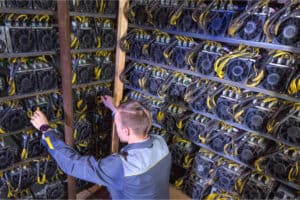The method involved with making Bitcoin devours around 96 terawatt-long stretches of power every year, more than is utilized by the Philippines, a country of around 110 million Bitcoin

Digital currencies have arisen as one of the most spellbinding, yet head-scratching, interests on the planet. They take off in esteem. They crash. They’ll change the world, their fans guarantee, by uprooting conventional monetary standards like the dollar, rupee or ruble. Some of them are named after canine images.
Furthermore, during the time spent just existing, digital forms of money like Bitcoin, one of the most famous, utilize shocking measures of power.
We’ll clarify how that functions in a moment. On the whole, think about this: The most common way of making Bitcoin devours around 96 terawatt-long stretches of power yearly, more than is utilized by the Philippines, a country of around 110 million.
That use, which is near a large portion of a-percent of all the power burned-through on the planet, has expanded about ten times in only the beyond five years.
The Bitcoin network utilizes about a similar measure of power as Washington state does in a year.
Furthermore, more than 33% of what private cooling in the United States goes through.
In excess of seven fold the amount of power as the entirety of Google’s worldwide tasks.
So Why Is It So Energy Intensive?
For quite a while, cash has been considered as something you can grasp — say, a dollar note.
Monetary forms like these seem like a particularly basic, splendid thought. An administration prints some paper and ensures its worth. Then, at that point we trade it among ourselves for vehicles, treats and cylinder socks. We can offer it to whomever we need, or even obliterate it.
On the web, things can get more convoluted.
In 2008, an obscure individual or people utilizing the name Satoshi Nakamoto distributed a proposition to make a cashlike electronic installment framework that would do precisely that: Cut out the mediators. That is the beginning of Bitcoin.
Bitcoin clients wouldn’t host to trust a third gathering — a bank, an administration or whatever — Nakamoto said, in light of the fact that exchanges would be overseen by a decentralized organization of Bitcoin clients. All in all, no single individual or substance could handle it. All Bitcoin exchanges would be transparently represented in a public record that anybody could analyze, and new bitcoins would be made as an award to members for assisting with dealing with this immense, rambling, automated record. Be that as it may, a definitive stock of bitcoins would be restricted. The thought was that developing interest over the long haul would give bitcoins their worth.
This idea required some investment to get on.
Yet, today, a solitary bitcoin is worth about $45,000 — albeit that could differ fiercely when you read this — and nobody can prevent you from sending it to whomever you like. (Obviously, if individuals somehow happened to be found purchasing unlawful medications or organizing ransomware assaults, two of the numerous unpalatable uses for which cryptographic money has demonstrated alluring, they would in any case be dependent upon the tradition that must be adhered to.)
In any case, as it occurs, dealing with an advanced money of that worth with no focal position takes a ton of registering influence.
1. It begins with an exchange.
Suppose you need to purchase something and pay with Bitcoin. The initial segment is fast and simple: You would open a record with a Bitcoin trade like Coinbase, which allows you to buy Bitcoin with dollars.
You presently have a “advanced wallet” with some Bitcoin in it. To spend it, you just send Bitcoin into the computerized wallet of the individual you’re purchasing something from. Simple as that.
However, that exchange, or actually any trade of Bitcoin, should initially be approved by the Bitcoin organization. In the easiest terms, this is the interaction by which the vender can be guaranteed that the bitcoins the individual is getting are genuine.
This gets to the actual heart of the entire Bitcoin accounting framework: the upkeep of the huge Bitcoin public record. What’s more, this is the place where a large part of the electrical energy gets devoured.
2. A worldwide speculating game starts.
From one side of the planet to the other, organizations and people known as Bitcoin excavators are contending to be the ones to approve exchanges and enter them into the public record of all Bitcoin exchanges. They fundamentally play a speculating game, utilizing amazing, and eager for power, PCs to attempt to destroy others. Since, in such a case that they are fruitful, they’re remunerated with recently made Bitcoin, which obviously is worth very much of cash.
This opposition for recently made Bitcoin is designated “mining.”
You can imagine it like a lottery, or a round of dice. An article distributed by Braiins, a bitcoin mining organization, gives a decent similarity: Imagine you’re at a club and everybody playing has a pass on with 500 sides. (All the more precisely, it would have billions of billions of sides, however that is difficult to draw.) The champ is the primary individual to move a number under 10.
The more PC power you have, the more estimates you can make rapidly. Thus, not at all like at the gambling club, where you have only one kick the bucket to move at human speed, you can have numerous PCs making many, many suppositions consistently.
The Bitcoin network is intended to make the speculating game increasingly more troublesome as more excavators take part, further putting a premium on quick, eager for power PCs. In particular, it’s planned so it generally takes a normal of 10 minutes for somebody to win a round. In the dice game relationship, if more individuals join the game and begin winning quicker, the game is recalibrated to make it harder. For instance: You presently need to move a number under 4, or you need to move precisely a 1.
That is the reason Bitcoin excavators presently have stockrooms loaded with incredible PCs, dashing at maximum velocity to figure enormous numbers and utilizing colossal amounts of energy simultaneously.
3. The champ procures a huge number of dollars in new Bitcoin.
The champ of the speculating game approves a norm “block” of Bitcoin exchanges, and is compensated for doing as such with 6.25 recently stamped bitcoins, every value about $45,000. So you can perceive any reason why individuals may rush into mining.
Bitcoin’s developing energy craving
In the beginning of Bitcoin, when it was less famous and worth little, anybody with a PC could undoubtedly mine at home. Less any longer.
Today you need exceptionally particular machines, huge amount of cash, a major space and enough cooling ability to hold the continually running equipment back from overheating. That is the reason mining currently occurs in monster server farms possessed by organizations or gatherings of individuals.
Truth be told, tasks have solidified such a lot of that now, just seven mining bunches own almost 80% of all figuring power on the organization. (The point behind “pooling” registering power like this is to appropriate pay all the more equally so members get $10 each day instead of a few bitcoins at regular intervals, for instance.)
Bitcoin mining implies something other than outflows. Equipment stacks up, as well. Everybody needs the freshest, quickest hardware, which causes high turnover and another e-squander issue. Alex de Vries, a Paris-based financial expert, gauges that consistently and a half or thereabouts, the computational force of mining equipment copies, making more established machines old. As per his estimations, toward the beginning of 2021, Bitcoin alone was creating more e-squander than numerous moderate size nations.
“Bitcoin diggers are totally disregarding this issue, since they don’t have an answer,” said de Vries, who runs Digiconomist, a site that tracks the maintainability of cryptographic forms of money. “These machines are recently unloaded.”
Could it be greener?
Imagine a scenario in which Bitcoin could be mined utilizing more wellsprings of sustainable power, similar to wind, sunlight based or hydropower.
It’s interesting to sort out precisely the amount of Bitcoin mining is controlled by renewables due to the actual idea of Bitcoin: a decentralized cash whose excavators are to a great extent unknown.
Around the world, evaluations of Bitcoin’s utilization of renewables range from about 40% to practically 75%. In any case, as a rule, specialists say, utilizing sustainable power to control Bitcoin mining implies it will not be accessible to control a home, a plant or an electric vehicle.
Could the manner in which Bitcoin works be changed to utilize less energy? Some other minor digital forms of money have advanced an other accounting framework, where preparing exchanges is won not through computational work but rather by demonstrating responsibility for coins. This would be more productive. Be that as it may, it hasn’t been demonstrated at scale, and isn’t probably going to grab hold with Bitcoin in light of the fact that, among different reasons, Bitcoin partners have an amazing monetary motivator not to change, since they have effectively put such a great amount in mining.
A few governments are as careful about Bitcoin as hippies are. If they somehow happened to restrict mining, that could hypothetically lessen the energy strain. Be that as it may, recollect, this is an organization intended to exist without go betweens. Spots like China are as of now making limitations around mining, however excavators are apparently moving to coal-rich Kazakhstan and the modest yet pained Texas electric network.
For years to come, Bitcoin’s energy utilization is probably going to stay unstable however long its cost does.
Despite the fact that Bitcoin mining probably won’t include pickaxes and hard caps, it’s anything but an absolutely advanced reflection, possibly: It is associated with the actual universe of non-renewable energy sources, power matrices and outflows, and to the environment emergency we’re in today. What was envisioned as a ground breaking advanced cash has as of now had certifiable consequences, and those keep on mounting.
Sources: Bitcoin authentic information from blockchain.com. Energy gauges from Cambridge Bitcoin Electricity Consumption Index. State-level, cooling and complete U.S. power utilization information from EIA. Google power information from Google’s 2020 natural report.







